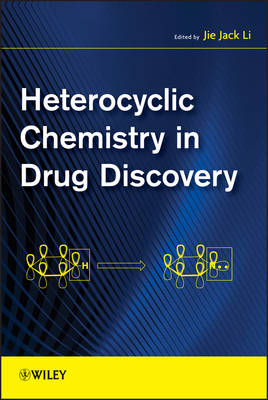
Heterocyclic Chemistry in Drug Discovery
John Wiley & Sons Inc (Hersteller)
978-1-118-50949-4 (ISBN)
- Titel ist leider vergriffen;
keine Neuauflage - Artikel merken
Chapter 1 Introduction 1 1.1 Nomenclature of Heterocycles 1 1.2 Aromatic Heterocycles 4 1.3 Importance of Heterocycles in Life 5 1.4 Importance of Heterocycles in Drug Discovery 8 PART I FIVE-MEMBERED HETEROCYCLES WITH ONE HETEROATOM 17 Chapter 2 Pyrroles 18 2.1 Introduction 18 2.2 Reactivity 22 2.3 Construction of the Pyrrole Rings 34 2.4 Palladium Chemistry of Pyrroles 44 2.5 Possible Liabilities of Pyrrole-Containing Drugs 46 2.6 Problems 49 2.7 References 51 Chapter 3 Indoles 54 3.1 Introduction 54 3.2 Reactivity of the Indole Ring 58 3.3 Construction of the Indole Rings 64 3.4 Oxindole-Containing Drug Synthesis 88 3.5 Cross-coupling Reactions for Indoles 91 3.6 Azaindole 104 3.7 Possible Liabilities of Drugs Containing 3-Methylindole 109 3.8 Problems 111 3.9 References 113 Chapter 4 Furans, Benzofurans, Thiophenes, and Benzothiophenes 119 4.1 Introduction 119 4.2 Furans and Benzofuran 126 4.3 Thiophenes and Benzothiophenes 158 4.4 Possible Liabilities of Furan and Thiophene-Containing Drugs 185 4.5 Problems 187 4.6 References 191 PART II FIVE-MEMBERED HETEROCYCLES WITH TWO OR MORE HETEROATOMS 197 Chapter 5 Pyrazoles, Pyrazolones, and Indazoles 198 5.1 Introduction 198 viii 5.2 Reactivity of the Pyrazoles and Indazoles 202 5.3 Construction of the Pyrazole and Indazole Rings 206 5.4 Pyrazolone-containing Drugs 217 5.5 Indazole-containing Drugs 220 5.6 Problems 223 5.7 References 226 Chapter 6 Oxazoles, Benzoxazoles, and Isoxazoles 231 6.1 Introduction 231 6.2 Construction of the Heterocyclic Ring 235 6.3 Reactivity 244 6.4 Cross-Coupling Reactions 250 6.5 Selected Reactions of Isoxazoles 269 6.6 Possible Liabilities of Oxazole-Containing Drugs 270 6.6 Problems 271 6.7 References 278 Chapter 7 Thiazoles and Benzothiazoles 283 7.1 Introduction 283 7.2 Reactions of the Thiazole Ring 290 ix 7.3 Palladium Chemistry Undergone by Thiazoles and Benzothiazoles 300 7.4 Construction of the Thiazole Ring 307 7.5 Construction of the Benzothiazole Ring 315 7.6 Possible Liabilities of Drugs Containing Thiazoles and Benzothiazoles 321 7.7 Thiazoles and Benzothiazoles as Bioisosteres 323 7.8 Problems 325 7.9 References 328 Chapter 8 Imidazoles and Benzimidazoles 333 8.1 Introduction to Imidazole 333 8.2 Reactivity of the Imidazole Ring 335 8.3 Construction of the Imidazole Ring 341 8.3.1 Debus 342 8.4 Conversion of Imidazolines to Imidazoles 353 8.5 Possible Liabilities of Imidazole-Containing Drugs 353 8.6 Introduction to Benzimidazole 354 8.7 Synthesis of Benzimidazoles: Classical Approaches 357 8.8 Construction of the Benzimidazole Core Using Transition Metal- Mediated Approaches 361 8.9 Alternative Cyclization Approach toward Benzimidazoles: Process Route toward BYK405879 367 8.10 Problems 368 8.11 References 370 Chapter 9 Triazoles and Tetrazoles 373 9.1 Introduction 373 9.2 Reactivity of the Triazole and Tetrazole Ring 375 9.3 Construction of the Triazole Ring 384 9.4 Possible Liabilities of Triazole-Containing Drugs 392 9.5 Problems 393 9.6 References 394 PART III SIX-MEMBERED HETEROCYCLES WITH ONE HETEROATOM 397 Chapter 10 Pyridines 398 10.1 Introduction 398 10.2 Reactivity of the Pyridine Ring 404 10.3 Construction of the Pyridine Ring 425 10.4. Problems 457 10.5 References 459 Chapter 11 Quinolines and Isoquinolines 471 11.1 Introduction 471 11.2 Reactivity of the Quinoline and Isoquinoline Ring 474 11.3 Construction of Quinoline Core 492 11.4 Construction of Isoquinoline Core 513 11.5 Possible Liabilities of Drugs Containing Quinoline and Isoquinoline Ring 526 11.6 Problems 527 11.7 References 528 PART IV SIX-MEMBERED HETEROCYCLES WITH TWO HETEROATOMS 535 Chapter 12 Pyrazines and Quinoxalines 536 12.1 Introduction 536 12.2 Formation of Diazines 539 12.3 Reactivity of the Molecules 545 12.4 Coupling Reactions 553 12.5 Problems 562 12.6 References 565 Chapter 13 Pyrimidines 569 13.1 Introduction 569 13.2 Construction of the Pyrimidine Ring 573 13.3 Synthesis of Pyrimidine-Containing Drugs 590 13.4 Problems 608 13.5 References 611 Chapter 14 Quinazolines and Quinazolones 615 14.1 Introduction 615 14.2 Reactions of Quinazolines and Quinazolinones 618 14.3 Quinazoline and Quinazolinone Synthesis 625 14.4 Synthesis of Quinazoline- and Quinazolinone-Containing Drugs 636 14.5 Problems 641 14.6 References 644 Subject Index 647
| Erscheint lt. Verlag | 22.2.2013 |
|---|---|
| Verlagsort | New York |
| Sprache | englisch |
| Maße | 214 x 275 mm |
| Gewicht | 1275 g |
| Themenwelt | Medizin / Pharmazie ► Medizinische Fachgebiete ► Pharmakologie / Pharmakotherapie |
| Naturwissenschaften ► Chemie ► Organische Chemie | |
| Technik | |
| ISBN-10 | 1-118-50949-8 / 1118509498 |
| ISBN-13 | 978-1-118-50949-4 / 9781118509494 |
| Zustand | Neuware |
| Informationen gemäß Produktsicherheitsverordnung (GPSR) | |
| Haben Sie eine Frage zum Produkt? |